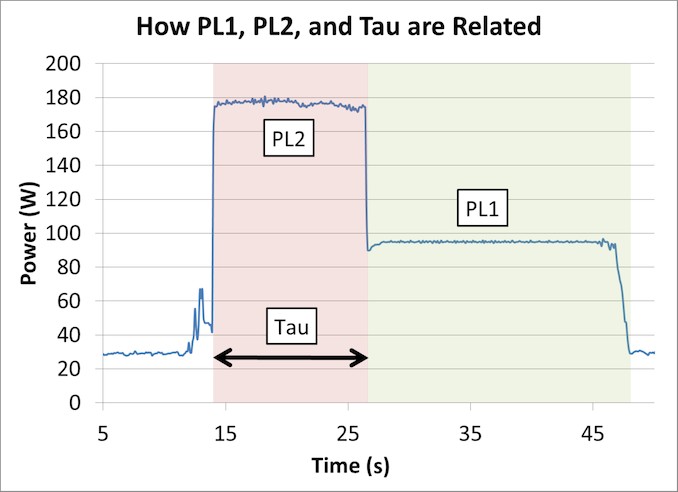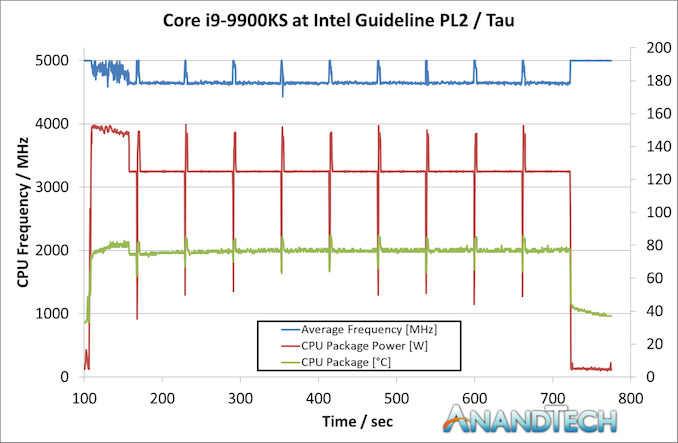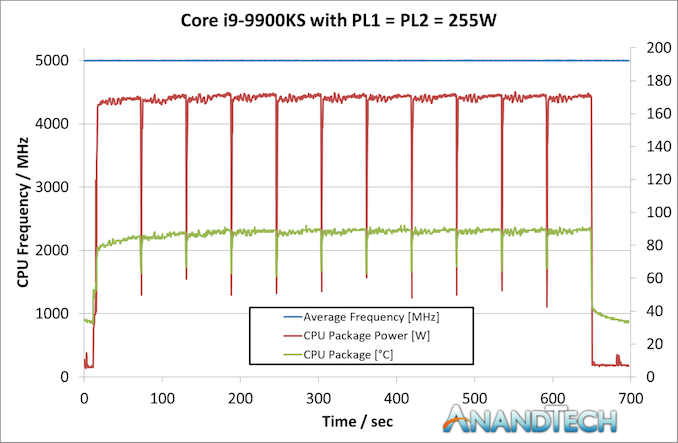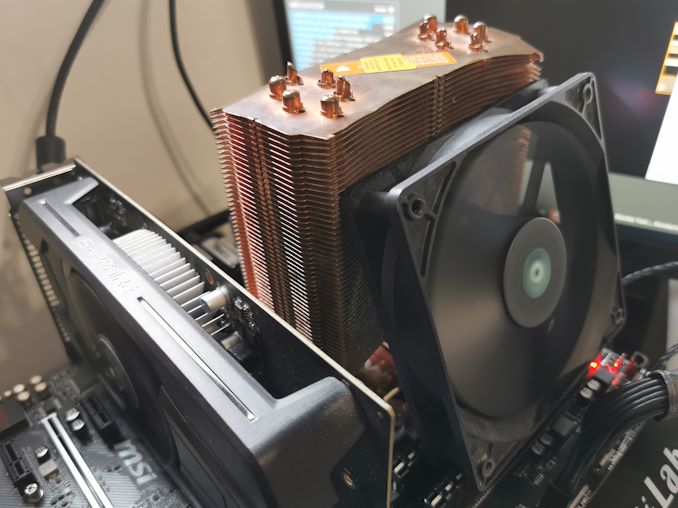The Intel Core i9-9900KS Review: The 5 GHz Consumer Special
by Dr. Ian Cutress on October 31, 2019 10:45 AM ESTGoing for Power
How to Manage 5.0 GHz Turbo
Intel lists the Core i9-9900KS processor as having a 127W TDP. As we’ve discussed at length [1,2] regarding what TDP means, as well as interviewing Intel Fellows about it, this means that the Core i9-9900KS is rated to require a cooling power of 127W when running at its base frequency, 4.0 GHz. Above this frequency, for example at its turbo frequency of 5.0 GHz, we are likely to see higher than 127W.
Now, I started saying in this review that the length of time that the processor will spend at 5.0 GHz will be motherboard dependent. This is true: Intel does not strictly define how long turbo should be enabled on any processor. It allows the motherboard manufacturer to ‘over-engineer’ the motherboard in order to help push the power behind the turbo higher and enable turbo for longer. The specific values that matter here are called PL2 (Power Limit 2, or peak turbo power limit), and Tau (a time for turbo).
For an Intel processor, each one has a ‘bucket’ of extra turbo energy. As the processor draws more power above its TDP (also called PL1), the bucket is drained to provide this energy. When the bucket is empty, the processor has to come back down to the PL1 power value, and eventually when the processor is less active below PL1, the bucket will refill. How big this bucket is depends on the value of PL1, PL2, and Tau. The bigger the bucket, the longer an Intel processor can hold its turbo frequency. Typically Tau isn’t so much as a time for turbo, but a scalar based on how big that bucket should be.

An example graph showing the effect of implementing Turbo on power/frequency
Motherboard manufacturers can set PL1, PL2, and Tau as they wish – they have to engineer the motherboard in order to cope with high numbers, but it means that every motherboard can have different long turbo performance. Intel even suggests testing processors on high-end and low-end motherboards to see the difference. Users can also manually adjust PL1, PL2, and Tau, based on the cooling they are providing.
For the Core i9-9900KS, Intel has given the PL1 value on the box, of 127 W. PL2 it says should at least be 1.25x the value of PL1, which is 159 W. Tau should be at least 28 seconds. This means, with a given workload (typically 95% equivalent of a power virus), the CPU should turbo up to 159 W for 28 seconds before coming back down to 127 W. A very important thing to note is that if the CPU needs more than 159 W to hit the 5.0 GHz turbo frequency, it will reduce the frequency until it hits 159 W. This might mean 4.8 GHz, or lower.
Despite giving us these numbers for PL1, PL2, and Tau, Intel also stated to us that they recommend that motherboard manufacturers determine the best values based on the hardware capabilities. The values of 127 W, 159 W, and 28 seconds are merely guidelines – most motherboards should be able to go beyond this, and Intel encourages its partners to adjust these values by default as required.
We tested Intel’s guidelines with a 10 minute run of Cinebench R20.
He we can see that at idle, the CPU sits at 5.0 GHz. But immediately when the workload comes on, it has to reduce the average CPU frequency because it goes straight up to the 159W limit – simply put, 159W isn’t enough to hit 5.0 GHz. We see the temperature slowly rise to 92C, but because the power isn’t enough the frequency keeps fluctuating.
By the end of the first Cinebench R20 section, it seems that the majority of it occurred during the turbo period. This means that this run scored almost the same as a pure 5.0 GHz run. However the subsequent runs were not as performant.
Because the turbo budget had been used up, the processor had to sit at 127 W, its PL1 value. At this power, the processor kept bouncing between 4.6 GHz and 4.7 GHz to find the balance. The temperatures in this mode kept stable, nearer 80C, but the performance of Cinebench R20 dropped around 8-10% because the CPU was now limited by its PL1/TDP value, as per Intel’s base configuration recommendation.
Going Beyond
Because motherboard manufactuers can do what they want with these values, we set the task on the motherboard we tested, the MSI Z390 Gaming Edge AC. By default, MSI has set the BIOS for the Core i9-9900KS with a simple equation. PL1 = PL2 = 255 W. When PL1 and PL2 are equal to each other, then Tau doesn’t matter. But what this setting does is state that MSI will allow the processor to consume as much power as it needs to up to 255 W. If it can hit 5.0 GHz before this value (hint, it does), then the user can turbo at 5.0 GHz forever. The only way that this processor will reduce in frequency is either at idle or due to thermal issues.
Here’s the same run but done with MSI’s own settings:
The processor stayed at a constant 5.0 GHz through the whole run. The CPU started pulling around 172W on average during the test, fluctuating a little bit based on exactly which 1s and 0s were going through. The CPU temperature is obviously higher, as we used the same cooling setup as before, and peaked at 92C, but the system was fully table the entire time.
Here was our system setup – a 2kg TRUE Copper air cooler powered by an average fan running at full speed in an open test bed.
But what this means is that users are going to have to be wary of exactly what settings the motherboard manufacturers are using. For those of you reading this review on the day it goes live, you’ll likely see more than a dozen other reviews testing this chip – each one is likely using a different motherboard, and each one might be using different PL2 and Tau values. What you’ve got here are the two extremes: Intel’s recommendation and MSI’s ‘going to the max’. Be prepared for a range of results. Where time has permitted, we’ve tested both extremes.













235 Comments
View All Comments
Korguz - Thursday, October 31, 2019 - link
one thing you should consoder.. NO cooling for this cpu at all.. so add at least $90 for that...AshlayW - Friday, November 1, 2019 - link
This too, the Intel CPU doesn't even include a cooler.liquid_c - Sunday, November 3, 2019 - link
AMD does, indeed, include a cooler. But stop acting like a frog and admit that you cannot (properly) use the CPU with that cooler. You'd still have to, eventually, get a AIO or a Noctua. So the fact that you'll have to pay an extra 90$ or so is moot, in this case.Korguz - Sunday, November 3, 2019 - link
moot ?? i dont think so, the cost of this cpu + $90 at least, just to be able to use it, ryzen 3000, no need for a cooler as it is included,if one wants better cooling, then it is an option, not a necessity, for the price, amd wins. for performance, for the most part, amd wins as well, specially in MT. and power usage, amd wins there again, you know, like how people were bashing amd for before zen cam out ?? WHY are people not bashing intel the SAME way now ??amnesia0287 - Friday, November 8, 2019 - link
3950x doesn’t include a cooler.Xyler94 - Thursday, October 31, 2019 - link
The cooling fan on X570 is if you're doing something as crazy as dual PCIe 4.0 NVMe RAID 0. Otherwise, they don't need to spin, as the passive heat dissipation is enough, and Gigabyte makes a board with no fan at all.It's great that Intel works better for you, but the use cases for it comes mostly down to super high refresh rates (240hz displays at 1080p) with medium settings. Otherwise, who cares if you lose maybe 5 frames if you're never gonna see those frames anyways, and if the 12 core Ryzen does almost everything better than the 8 core 9900KS in multi-threaded tasks, then I don't see the drawbacks in buying AMD.
Intel does lead AMD in the core speed and overclocking department however. If you're an enthusiast overclocker, then by all means, disregard AMD
AshlayW - Friday, November 1, 2019 - link
"Better Intel quality control and testing"Substantiated proof please? Otherwise, stop talking out of your backsie, many thanks.
Hey, look I can also be anecdotal: In 10 years of building PCs I've never had a CPU die, Intel or AMD, and only 3 motherboards, two of which was my fault.
Spunjji - Friday, November 1, 2019 - link
My anecdotes:I've had two AMD CPUs die. One was a Duron that I ran with the heatsink improperly mounted, causing it to go pop, and the other was a Barton core Athlon XP that had a corner of the die chip off from having a heavy CPU cooler dismounted and remounted too many times. Both my fault, albeit both consequences of design choices (no thermal regulation on the Duron, no protective heat spreader on the Barton)
I've had 3 Intel CPUs go faulty. All were Sandy Bridge, and every single one appeared to work correctly most of the time but would do weird things like suddenly stutter in games or crash without warning. None of them had been overclocked or otherwise "misused".
Off that basis I'd say AMD do better than Intel. *shrug*
Sivar - Friday, November 1, 2019 - link
AMD's random number generator instruction is crashing Linux and compromising security because it always reports that it can generate a legitimately random number, and it always generates the same one. This has made Sysd in Linux issue a patch that always assumes the generator is bad when it issues that value, a 0xffffffff, which means that when working instruction like Intel's generate that number legitimately, Linux will assume it is defective, too. If they had, say, tested the chip properly, the fact that many distributions of the world's most popular server operating have CPU-related crashes may have been found.AMD made the first chip I have ever used that could not run its stock speed stable, but could run underclocked (AthlonXP).
AMD owns the company formerly known as ATI. Somehow, the quality of their drivers is controversial, but after giving them 6 or 7 chances since the 90's, I will never use that hardware again due to the hilariously low-quality drivers and driver support software. The hardware is often fine, but has at many times been reputed to run too close to the line, requiring intense cooling with leaf blower-like fans, and allowing almost zero overclocking.
Really, the idea that AMD's QA is inferior to Intel's seems strange to even question. AMD, even with their successes here and there (AthlonXP, Athlon 64, Ryzen... and that's pretty much it) has always held a reputation for being the off-brand. Anecdotally, problems with AMD systems have long been considered more likely than with Intel.
I wish AMD the best, and I hope their next-gen Ryzen 4000 series shows a clear win over Intel other than in just core count, but for as excited as I was to get a 3800X or 3900X, when I looked at the numbers and at my own long history as an AMD advocate yet purveyor of fact, I had to conclude that AMD still doesn't quite measure up other than in specific corner cases.
Galid - Friday, November 1, 2019 - link
I owned multiple systems over the past here are some of the cpus: Intel 80286, intel pentium 133, intel pentium II 233 and 350, AMD Athlon 64 3200+, AMD Athlon x2 4200+, Intel Core 2 duo e5400 and q6600, AMD FX-8350, intel i5 2500k and then my brother got a ryzen 3700x that we just built lately. I won't go into all the video cards I've owned/purchased to build systems for my friends/family but here are some of them: ATI rage 128, Nvidia riva tnt2, geforce 2 mx, ATI Radeon 8500, ATI radeon 9700 non-pro, Nvidia 8800 gt, ATI radeon 4850 then upgraded to 4870 1gb and then I pretty much tried everything that came out after that for both team.Sincerely, the biggest problems I've had so far was my geforce 6800 gt's drivers totally incompatible with my Athlon 64 x2 3200+ and that was due to the chipset. Nvidia knew the problem was widespread. We could only fix this by using a very old driver(can't remember which) and sometimes underclock would work. They never fixed this.
My father still uses the FX-8350 and that cpu was not well received back in the days. He has no problems whatsoever.
Again, I'm not a linux user but I've got a friend who swears by linux and he uses AMD hardware. I could ask him why but I do not really care anyway. I remember when I bought my i5 2500k there was a major recall on motherboard including mine for b3 stepping because of the S-ATA controller risk of dying or something like that. 90% of the systems I named above are still running strong and of that 10% dead, it's mostly the motherboards or ram, which aren't built by AMD nor INTEL.
I'm no fanboy, I bought so many systems with always the same objective being the best performance for the dollar depending on the usage of the said system. I just had to comment because when I see someone commenting like that, I think they were simply unlucky and that it has nothing to do with what they beleive.